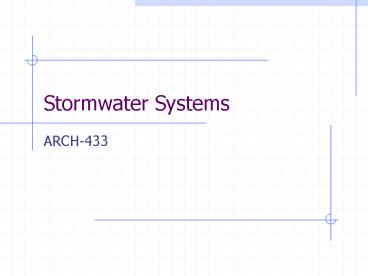Stormwater Systems - PowerPoint PPT Presentation
1 / 42
Title:
Stormwater Systems
Description:
Stormwater Systems ARCH-433 * * Flow Control Roof Drain System A. Advantages 1. Fewer drains 2. Smaller piping B. Disadvantages 1. Adds a lot of weight to the ... – PowerPoint PPT presentation
Number of Views:137
Avg rating:3.0/5.0
Title: Stormwater Systems
1
Stormwater Systems
- ARCH-433
2
Attendance
- This water closet, installed in Pullman,
Washington, flushes in a counterclockwise
rotation. In what direction would the water
rotate if it is installed in Sydney, Australia?
3
What You Need To Know
- Understand how and why stormwater systems operate
- Know the differences between stormwater and
sanitary systems - Strategies available for reducing potable water
use - LEED credit points associated with a reduction in
potable water use
4
What You Need To Be Able To Do
- Predict stormwater drainage problems
- Be able to sketch a stormwater riser diagram
- Correctly size a stormwater system
- Calculate the amount of stormwater available for
non-potable uses - Make management decisions on the use and
implementation of stormwater systems
5
Terms
- Stormwater systems
- Roof drain (RD)
- Overflow system (OFL)
- Leader
- Flow control roof drain
- Downspout nozzle (DSN)
- Imperviousness
- Stormwater Harvesting
- Area Drain
6
Purpose of Stormwater Systems
- Collect stormwater from the roof and move it to a
point of disposal away from the foundation - Collect stormwater from the site and move it to
an approved point of disposal
7
Difference Between Sanitary and Stormwater Systems
- Absence of volatile gases
- No traps required
- No venting required
- Point of disposal varies
8
Stormwater Discharge Points
- Grade
- Municipal storm sewer system
- Street
- Stream, river, lake, ocean or other suitable
point - Yes BUT, is this really what we want!
- New Code Requirements
9
Stormwater Systems
- Roof drain systems
- Flat roofs
- Pitched roofs
- Site systems
- Qflow Area (acres) x CR x IR Ft3/Sec
10
Roof Drain Systems
- Pitched Roofs
- Gutters and leaders
- Flat Roofs
- Roof drains
- Overflow drains
- Flow control systems
11
Flat Roofs
- Advantages?
- Disadvantages?
12
Strategies - Roof Design
13
Strategies Roof Design
14
Sizing Stormwater Systems
- Variables for commercial roof drain systems
- Area of the roof
- Rainfall rate
- Number of roof drains
- Slope of piping
- Variables for residential gutter systems
- Area of the roof
- Rainfall rate
- Number of gutters
- Slope of gutter
15
What about Parking Structures
- Floor Drains
- Poor Design Consideration
- Designed by an Architect
- Designed by an Engineer
- Concrete rot
- Repairs
16
Roof Drains in a Flat Roof
17
Rainfall Rate (Table 8-15)
18
Pipe Capacity (Table 8-16)
19
Overflow Drain Systems
OFL
2
RD
Beware of shortcuts!
DSN
20
(No Transcript)
21
Overflow Drain Systems
- Required by virtually every code
- Prevents overloading of the structure
22
Drain Installation
23
Overflows
- Can also use scupper drains
- Advantages
- Disadvantages
24
(No Transcript)
25
(No Transcript)
26
Strategies - Flow Control Roof Drain System
27
Siphonic Drain Systems
Air Baffle
28
(No Transcript)
29
LEED SS Credit 6.1
- Credit 6.1
- Option 1 Existing Imperviousness is 50
(undeveloped sites) - Implement a stormwater management plan that
prevents the post development discharge rate and
quantity from exceeding the pre-development
levels or - Implement a stormwater management plan that
protects receiving stream channels
30
LEED SS Credit 6.1
- Credit 6.1
- Option 1 Existing Imperviousness is 50
(undeveloped sites)
Protect stream channels from excessive velocity
31
LEED SS Credit 6.1
- Credit 6.1
- Option 2 Existing Imperviousness is 50
- Implement a stormwater management plan that
results in a 25 decrease in volume of stormwater
runoff from the two-year, 24 hour storm
32
LEED SS Credit 6.1
- Credit 6.1
- Option 2 Existing Imperviousness is 50
- Bioswales
- Cisterns, holding ponds
- Green roofs
- Rainwater harvesting
33
LEED SS Credit 6.2
- Credit 6.2
- Implement a stormwater management plan that
reduces impervious cover, promotes infiltration
and captures and treats stormwater runoff from
90 of the average annual rainfall using
acceptable best management practices (BMP) - Remove 80 of the average annual post Total
Suspended Solids (TSS)
34
LEED WE Credit 2
- Credit 2
- Reduce the use of municipally provided potable
water for building sewage conveyance by at least
50 - or
- Treat 100 of wastewater on site to tertiary
standards
35
Water Reduction Strategies
- Use of Stormwater/Grey water to
- Flush water closets and urinals
- Water landscape
- Avoid non-native plants
- Reduce the amount of water flowing across site
36
Carpenter
- How much stormwater (clear water) do we need?
- ? gals per day to flush low flow water closets
- How many work days per year?
37
How Much Rainwater is Available?
- Based upon .62 gallons/inch/sq. ft.
- Efficiency varies between 75 and 90
- V collected Rainfall x Area x Efficiency x .62
gals/inch/sq. ft.
Source Texas Manual on Rainwater Harvesting, 3rd
Edition, 2005
38
Rainwater Harvesting Capacity
Source National Oceanic and Atmospheric
Administration, Department of Commerce
39
Calculating Water Storage
40
What is Wrong with this Picture?
41
Strategies
- Two 7,500 gal tanks installed to capture
rainwater - Rainwater is filtered with a recirculation system
and used to flush water closets - Capture system reduces stormwater discharge
42
Green Roofs































